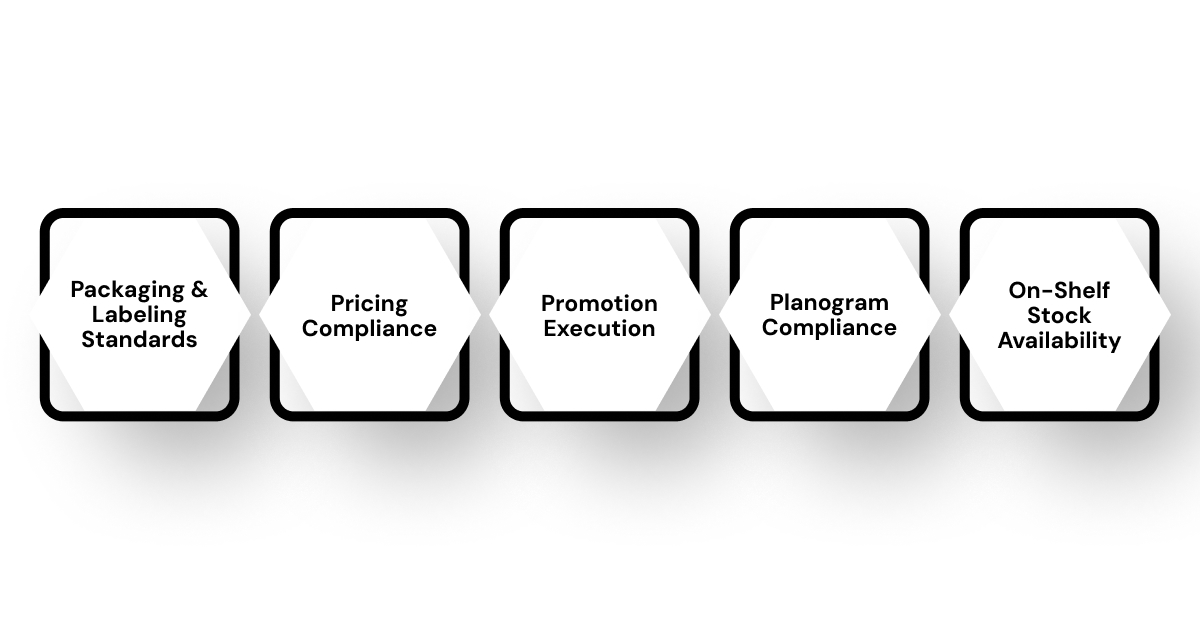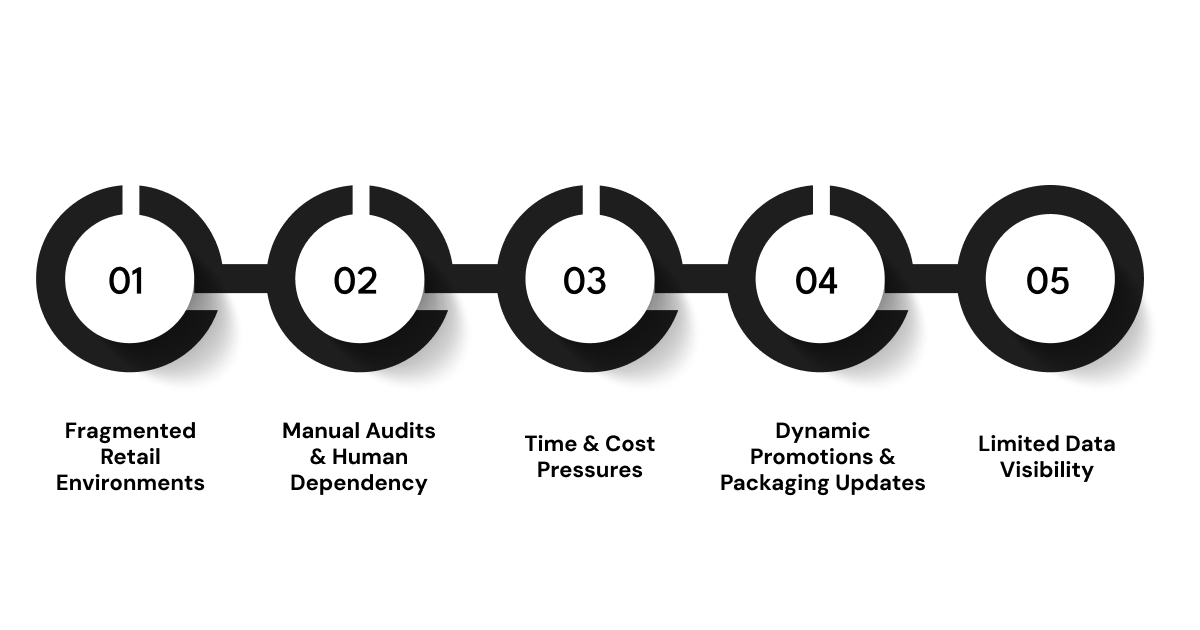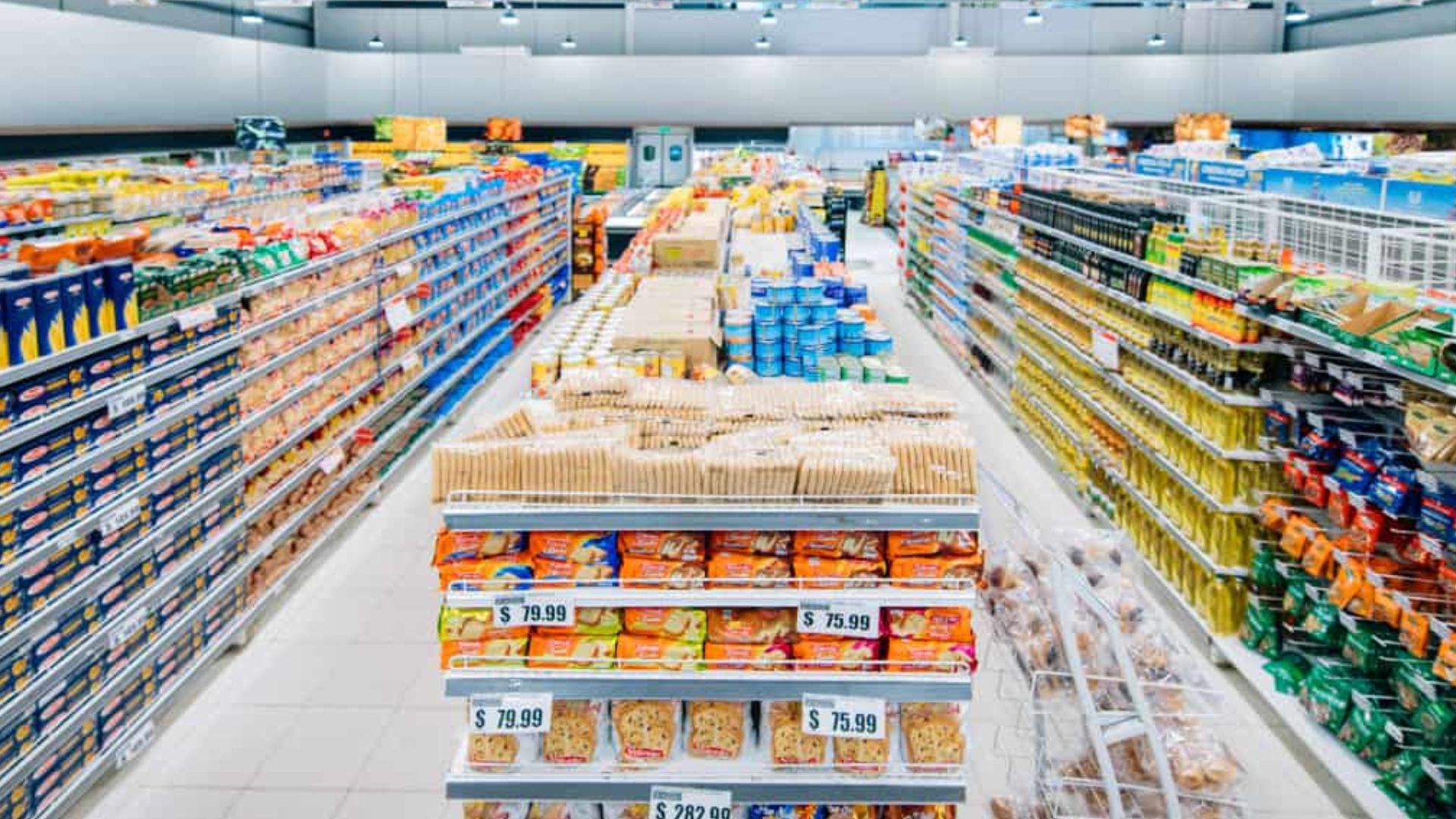For consumer packaged goods (CPG) companies, brand consistency is more than design and messaging; it’s about execution at scale. In 2025, ensuring compliance has become more complex as brands expand globally and adopt AI-driven monitoring tools for in-store execution.
A misplaced product on the shelf or a pricing deviation across markets may seem small, but it can damage brand equity and reduce trust. With the brand compliance software market projected to grow by nearly $6 billion by 2033 at a 15% CAGR, this indicates the need for CPG brands to improve their monitoring strategies.
Brand compliance monitoring gives CPGs the visibility they need to protect their image in crowded, fast-moving retail environments. By proactively tracking how products are displayed, priced, and promoted in stores, brands can reduce execution gaps and ensure they are represented exactly as intended.
In a nutshell:
- Importance of Compliance: Monitoring ensures brand consistency, safeguards trust, and prevents revenue loss from errors like stockouts or pricing mistakes..
- Core Components: It covers packaging, pricing, promotions, planogram adherence, and shelf availability for consistent execution across stores.
- Challenges Faced: Large retail networks, manual audits, time pressures, and a lack of real-time insights make compliance hard to maintain.
- Future Outlook: AI-powered analytics, automation, and mobile-first tools are shaping predictive, data-driven monitoring for smarter in-store execution.
What is Brand Compliance Monitoring for CPGs?
Brand compliance monitoring is the systematic process of ensuring that a brand’s products are displayed, priced, and promoted according to established standards across retail locations. For CPGs, this means checking whether guidelines are being followed consistently across thousands of stores. This can include:
- Correct packaging and branding visible on the shelf.
- SKUs placed according to the approved planogram.
- Promotions executed as per agreements.
- Prices displayed accurately to avoid misrepresentation.
In simple terms, it is about making sure the brand you designed in the boardroom is the same brand customers see on the store shelves.
Why is Brand Compliance Monitoring Crucial for CPGs?
Ensuring brand compliance in physical stores is vital for CPG companies because even small lapses affect sales, brand reputation, and competitive positioning. Key reasons include:
- Preserving Brand Equity and Customer Trust: If a product is missing from the shelf, or placed incorrectly, or promotion signage is wrong, it can confuse or disappoint shoppers. Over time, this reduces trust and the perceived quality or professionalism of the brand.
- Avoiding Revenue Leakage: Stockouts, misplaced items, or mis-displayed promotions often lead directly to lost sales. A promotion that doesn’t get implemented as planned (or pricing that shows incorrectly) can mean paying for an offer that never had its intended effect.
- Meeting Retailer Agreements: Many CPGs have contracts or agreements with retailers that specify where products should be placed, how promotions should be displayed, and what promotional pricing should apply. Failing to comply can strain relationships or reduce support.
- Regulatory and Competitive Pressure: As regulations tighten (for example, around labelling, pricing disclosures, or promotion transparency), brands face more scrutiny. Competitors who maintain compliance gain better visibility, leaving non-compliant products behind.
- Enabling Better Decision Making: Without accurate, store-level visibility, brands make decisions based on assumptions. Compliance monitoring provides real insights into placement accuracy, promotion adherence, and planogram compliance, helping allocate marketing resources and improve sales strategy.
Key Components of Brand Compliance Monitoring for CPGs

Brand compliance covers multiple aspects of in-store execution. Each component plays a role in ensuring that a brand’s promise is delivered consistently to customers.
1. Packaging and Labeling Standards
Packaging is the first point of contact a customer has with a brand. Monitoring verifies that every product uses the correct design, labeling, and regulatory information.
Even minor deviations, like missing logos or wrong label placement, affect brand perception and may violate regulations. Regular checks maintain uniformity and reinforce brand identity across retail locations.
2. Pricing Compliance
Accurate pricing is essential for building customer trust and promotional effectiveness. Brand compliance monitoring verifies that products are priced as intended in every store, preventing errors that can lead to lost sales or competitive disadvantage.
By keeping pricing consistent, CPGs can reduce customer confusion and maintain the perceived value of their products.
3. Promotion Execution
Promotions are key drivers of sales and visibility, but only work if executed correctly.. Compliance monitoring checks that offers, discounts, and in-store displays are implemented according to plan.
This ensures that the promotional strategy reaches its full potential, helping CPGs maximize ROI on marketing campaigns and keep execution consistent across all stores.
4. Planogram Compliance
Planograms define the exact placement and arrangement of products on shelves to optimize visibility and shopper engagement. Monitoring ensures that products follow these guidelines precisely, including correct positioning, adjacency, and quantity.
Consistent planogram compliance helps brands compete, avoid lost sales, and maintain a reliable brand in-store presence.
5. On-Shelf Stock Availability
Even the best plans fail if products are missing from the shelf. Monitoring on-shelf stock availability ensures that products are always present and accessible to customers.
By quickly identifying out-of-stock situations, CPGs can take timely action to update shelves, protect revenue, and maintain a strong in-store presence.
Challenges in Brand Compliance Monitoring for CPGs

Despite its importance, brand compliance monitoring is not easy. CPGs face several execution challenges, especially when dealing with large-scale retail networks.
1. Fragmented Retail Environments
CPG brands often operate across thousands of outlets, from large supermarkets to small convenience stores. Each store has different layouts, shelving arrangements, and staff familiarity with brand guidelines.
For example, a popular snack brand may be correctly placed on eye-level shelves in major supermarkets but stacked at the bottom in smaller local stores, reducing visibility. Manually monitoring every location for consistency is resource-intensive and prone to errors.
2. Manual Audits and Human Dependency
Traditional monitoring relies on field agents physically inspecting shelves and reporting deviations. This process is slow and often inconsistent.
For instance, a beverage brand may launch a limited-edition flavor, but if field staff miss its placement in a few stores, reports will reflect incomplete data. These gaps can prevent timely corrective action and impact brand presentation.
3. Time and Cost Pressures
Conducting regular audits across multiple regions consumes significant time and resources. Field teams often prioritize high-revenue stores, leaving smaller outlets unchecked.
For example, a packaged food company may discover weeks later that promotional displays for a new cookie range weren’t set up in several mid-sized supermarkets, resulting in missed sales opportunities.
4. Dynamic Promotions and Packaging Updates
Frequent promotional campaigns and packaging updates add complexity. For example, a personal care brand launching a seasonal offer may face delays if stores don’t implement it correctly.
Without real-time tracking, field teams may struggle to ensure that all outlets display the new products and promotions as intended, creating inconsistent brand experiences.
5. Limited Data Visibility
Relying solely on manual audits often means brands won’t see shelf conditions until reports are submitted. For instance, a beverage brand may only learn weeks later that a competitor’s product has displaced their own due to poor shelf compliance, delaying corrective actions and affecting revenue.
Real-time visibility is essential to detect and resolve issues proactively, ensuring planogram adherence and promotional accuracy.
Strategies for Effective Brand Compliance Monitoring for CPGs
To make compliance monitoring effective, CPGs need strategies that balance accuracy, scalability, and speed. A proactive approach helps identify and correct compliance gaps immediately.
Here are a few strategies that CPG brands should adopt:
1. Establish Clear Compliance Guidelines
A strong compliance strategy begins with well-defined standards. CPG brands should clearly document packaging, pricing, planogram, and promotional requirements.
When everyone, from field agents to regional managers, knows what “compliant execution” looks like, it reduces confusion and ensures consistency. Clear guidelines also serve as a benchmark for measuring performance across stores.
2. Use Technology for Shelf Data Collection
Manual audits are time-consuming and prone to errors, especially across multiple retail locations. AI-powered image recognition tools help CPGs collect accurate shelf data efficiently.
Automation allows brands to cover more stores, detect non-compliance instantly, and maintain a consistent view of product placement, pricing, and promotions.
3. Focus on Actionable KPIs
Tracking the right metrics is essential for effective monitoring. Instead of vague measures, CPGs should focus on on-shelf stock availability, share of shelf, planogram compliance, and promotion execution.
These KPIs provide field teams and sales managers with actionable insights to fix issues immediately and improve retail execution.
4. Empower Field Teams with Real-Time Data
Providing field agents with instant shelf-level insights enables faster corrective action. With real-time shelf data, teams can immediately address missing stock, misaligned products, or promotional errors, ensuring consistent brand representation.
5. Build Feedback Loops for Continuous Improvement
Monitoring alone isn’t enough; brands need a system to learn from the data. By analyzing compliance patterns over time, CPGs can identify recurring issues, refine execution processes, and strengthen collaboration with retailers.
Continuous feedback loops ensure corrective measures are applied promptly and strategies evolve with changing store dynamics.
By combining disciplined processes with technology, CPG brands can turn compliance monitoring into a competitive advantage.
The Role of AI and Automation in Brand Compliance for CPGs

AI and automation have transformed brand compliance monitoring from a slow, manual process into a fast and efficient process. These tools help CPG teams scale audits, reduce errors, and quickly see where improvements are needed.
- Automated Shelf Scanning at Scale: AI-powered image recognition captures thousands of shelf images across multiple stores, processing them instantly to detect compliance gaps without needing manual audits.
- Real-Time KPI Updates: Automation provides immediate insights on planogram deviations, stockouts, and promotional compliance, helping teams fix errors before they affect sales or brand perception.
- Historical Trend Analysis: AI can analyze historical shelf compliance data to identify patterns, evaluate long-term performance of specific campaigns, and guide future brand execution strategies.
- Optimized Field Force Deployment: Automation helps determine which stores require immediate attention versus routine checks, ensuring that field agents are deployed where they can have the biggest impact on compliance.
- Reduced Reporting Delays: Automation eliminates the need for manual report compilation, so that management can access consolidated compliance data immediately for faster decisions.
Future Trends in Brand Compliance Monitoring for CPGs
As the retail environment becomes more complex, brand compliance will continue to evolve. The future lies in predictive, data-driven monitoring that predicts risks before they happen.
- Hybrid Audits Combining AI and Human Oversight: AI and image recognition let brands track compliance at the store, city, or regional level. This makes it easier to take corrective actions where they are most needed.
- Geo-Tagged Compliance Insights: Real-time mapping of compliance across stores by location helps brands pinpoint regions or store types where execution gaps are frequent and prioritize corrective action.
- Adaptive AI Models for Changing Retail Dynamics: AI systems continuously learn from new in-store patterns, seasonal promotions, and changing planograms. This reduces manual work and improves predictive monitoring.
- Cross-Category Benchmarking: Brands will increasingly measure compliance performance not only within their category but also against competitors’ shelf presence, helping identify weaker segments or stores that can make the biggest impact.
- Mobile-First Compliance Monitoring: Field teams will increasingly use mobile apps to capture images and check planogram compliance instantly. These apps also provide insights on the go, helping teams cover more stores without extra resources.
- Automated Compliance Alerts and Recommendations: Future platforms will not just report issues—they will suggest corrective actions, like moving SKUs or updating displays, so that brands can fix problems quickly.
How ParallelDots Can Assist in Brand Compliance Monitoring for CPGs?
ParallelDots offers advanced AI-powered solutions tailored to the unique challenges faced by CPG brands in maintaining brand compliance across physical retail environments. Its real-time image recognition and computer vision technologies help CPG brands monitor and enforce brand standards effectively without relying on manual checks.
Here’s how we can help:
1. Real-Time On-Shelf Stock Visibility
ParallelDots ShelfWatch helps CPG brands overcome fragmentation by visually monitoring thousands of stores simultaneously. It identifies stockouts and low-visibility SKUs instantly, enabling field teams to act before sales are lost. Continuous shelf monitoring ensures products are available across all outlets, protecting revenue and maintaining a consistent brand presence.
2. Share of Shelf Tracking
Understanding shelf space relative to competitors is crucial for market share growth. ShelfWatch captures share-of-shelf metrics in real time, allowing brands to prioritize high-performing SKUs and optimize product placement. This automated tracking reduces reliance on manual audits and ensures consistent visibility across stores of different sizes and layouts.
3. Planogram Compliance Monitoring
Frequent changes in promotions and product placement can disrupt brand consistency. ShelfWatch automatically detects misplacements, missing SKUs, or deviations from approved planograms across all stores. This ensures that every store reflects brand guidelines accurately, protecting equity and maintaining uniform presentation.
4. Promotion and Pricing Verification
Executing promotions and pricing strategies accurately is essential for converting marketing investments into sales. ParallelDots ShelfWatch monitors promotional displays and pricing compliance in real time, alerting teams to deviations immediately. This reduces delays in reporting and ensures every campaign performs as intended, even in dynamic retail environments.
5. Scalable, Automated Store Audits
Manual audits are slow and prone to error, especially under time and cost pressures. ParallelDots automates shelf monitoring with AI-powered image recognition, expanding coverage across more stores, reducing human error, and accelerating insights. Field agents can focus on corrective actions rather than data collection, making compliance monitoring faster, more efficient, and scalable.
By integrating ParallelDots' solutions, CPG brands can proactively manage brand compliance, mitigate risks, and protect brand equity in the competitive retail landscape. Request a demo today to see how ParallelDots can simplify brand compliance monitoring.
Frequently Asked Questions
1. How does brand compliance monitoring differ from general retail execution tracking?
Brand compliance monitoring focuses on ensuring products, pricing, promotions, and displays align with brand guidelines, while retail execution tracking tracks operational tasks like stock levels, planogram adherence, and sales performance. Compliance monitoring ensures consistency and legal adherence, whereas execution tracking measures efficiency and operational accuracy.
2. What are the cost implications of poor compliance monitoring in CPG?
Poor compliance monitoring can lead to revenue loss, fines, and legal penalties, along with brand reputation damage. It may result in mislabeling, pricing errors, or promotional mismatches, reducing consumer trust and market share. Long-term operational inefficiencies and corrective expenses also increase, affecting profitability across multiple markets and channels.
3. How can CPGs measure packaging and labeling compliance across markets?
CPGs can use digital audits, image recognition tools, and store inspections to compare products against regulatory and brand standards. Automated platforms track deviations in labeling, barcodes, ingredients, and design elements across regions. Centralised reporting enables real-time monitoring, ensuring consistent compliance across multiple markets while quickly identifying and resolving discrepancies.
4. What metrics should CPGs use to evaluate compliance effectiveness?
Key metrics include percentage of compliant stores, audit pass rates, labeling and packaging errors, promotional accuracy, and time to resolve non-compliance issues. Tracking deviations per region or category and measuring repeat violations helps identify trends, improve processes, and ensure adherence to both brand standards and regulatory requirements.
5. How often should compliance audits or checks be performed?
Frequency depends on market complexity, product turnover, and regulatory requirements. High-risk or fast-moving products may require weekly checks, while standard categories can be audited monthly or quarterly. Regular audits ensure early detection of non-compliance, maintain brand consistency, and reduce operational and legal risks across regions


